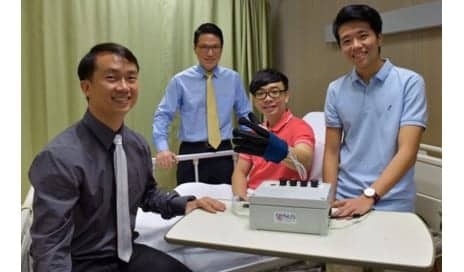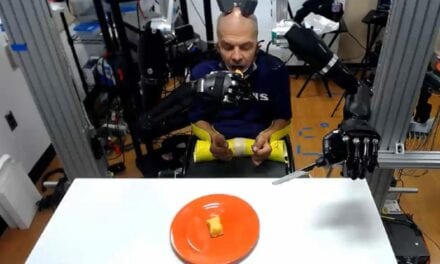
The EsoGlove is designed to help restore hand movement in patients who have lost their hand functions due to injuries or nerve-related conditions. (Photo credit: National University of Singapore)
A research team has developed a lightweight and smart robotic glove to help restore movement in those who have lost function in their hand due to injuries or nerve-related conditions.
Dubbed the EsoGlove, the robotic device—developed by researchers at the National University of Singapore (NUS)—has sensors that detect muscle signals and conforms to the natural movements of the human hand, reducing discomfort and risk of injury. It is also compact and portable, according to a media release from the university.
“EsoGlove is designed to enable patients to carry out rehabilitation exercises in various settings – in the hospital wards, rehabilitation centers, and even at home. Equipped with technology that can detect and interpret muscle signals, EsoGlove can also assist patients in daily activities, for instance by guiding the fingers to perform tasks such as holding a cup,” explains Assistant Professor Raye Yeow from the NUS Department of Biomedical Engineering, part of the research team, in the release.
Unlike conventional robotic devices for hand rehabilitation, which consist of rigid electro-mechanical components, the EsoGlove is made of soft components that don’t require mechanical setups. Yeow notes that the glove’s main body is made of fabric, with soft actuators embedded, and has adjustable Velcro straps.
EsoGlove is connected to a pump-valve control system that modulates the air pressure, which directs the soft actuators. When the actuators are pressurized by air, they apply distributed forces along the length of the finger to promote finger movements, such as bending, extending, and twisting, to support different hand motions, the release explains.
EsoGlove uses an intuitive control mechanism that involves the coupling of electromyography and radio-frequency identification technologies. With this feature, the robotic glove can detect a patient’s intent to perform a hand action on a particular object, such as picking up a pen or holding a mug. By interpreting the muscle signals of the wearer, the robotic glove can help the patient move the fingers to accomplish the specific tasks, involving objects of various shapes and sizes, in an intuitive manner, the release continues.
Yeow and the rest of the research team plan to start pilot clinical studies at NUS in February to validate the device and to receive feedback to help them further refine the device’s design. They have also filed a patent for the EsoGlove and have begun a company to help bring the glove to market.
[Source(s): National University of Singapore, Science Daily]






when is Esoglove going to be on the market to buy?